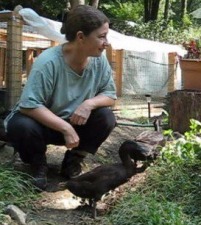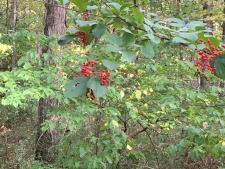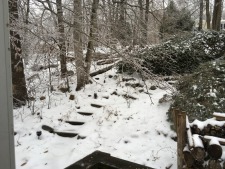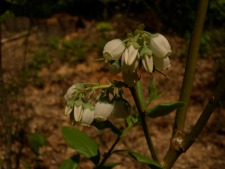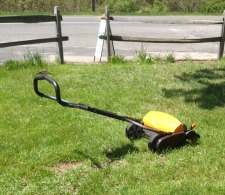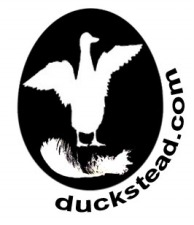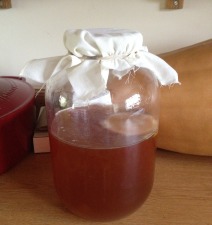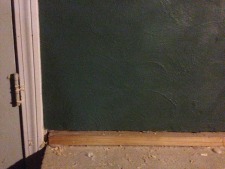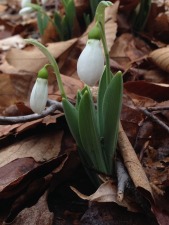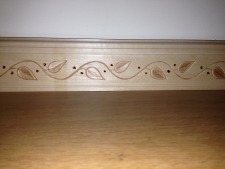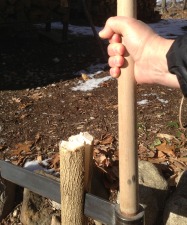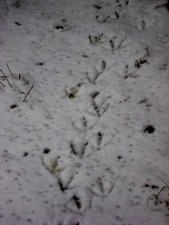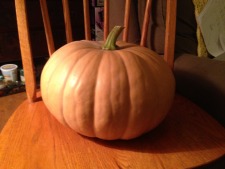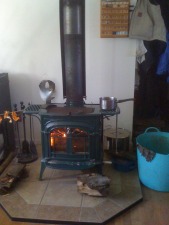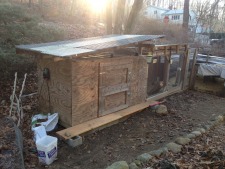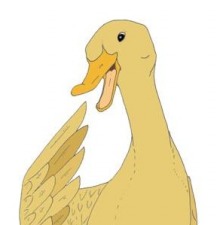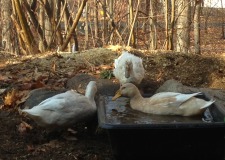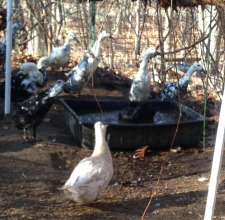Sep 12, 2021New Video on Improving the Health of Land - Recognizing Plants
Duckstead on Vimeo - Know Plants, Save Money |
Feb 17, 2019Guerrilla Gardening Workshop at Laughing Dog FarmYesterday my beloved and I traveled to Laughing Dog Farm in Gill, Massachusetts (U.S.) for a workshop on guerrilla gardening. I had wanted to meet Danny Botkin and Divya Shinn for some time, since learning about their work through social media.So when the announcement for the workshop appeared, I signed up right away. My beloved also wanted to see how they do it. And who can resist a visit to a farm named in honor of one of the most amazing creatures ever? Here is the url to explain: https://laughingdogfarm.com/n/27/Shebas-Eulogy---Spring-1988 And there are goats. When there are goats involved, I want to know more. Let´s get back to guerrilla gardening. According to Danny Botkin: “Guerrilla gardening might be described as a way of viewing food growing that is less planful and formulaic and more opportunistic, situational and intuitive. Such a farmer responds nimbly to unexpected windfalls and shifting circumstances, rather than reflexively following fixed protocols, plans or formulas. All farmers are called upon to improvise based on situational opportunity. However the guerrilla gardener tends to exploit unlikely “niches” and high-risk endeavors.” We arrived at the appointed time and were warmly greeted by Danny and Divya. We had an opportunity for a brief chat with another couple before the workshop began. There were a few couples, and the age range was from 20’s through 70’s, by my estimate. It was encouraging to have a group of friendly folk to learn with! Once everyone was assembled, Dan provided the formal welcome and overview of the farm, 3+ acres on a hilltop, two greenhouses, low tunnels, fruit and nut trees, barnyard (remember the goats?), barn, and house. One greenhouse has a rounded roof, the other a “gothic” roof with a sharper peak. Danny recommends the latter in snowy climates, as the snow does not build up on it, eliminating the risk of collapse from snow load. It was one of the many details he shared during the workshop. The low tunnels (miniature greenhouses) can be set up standalone as cold frames for season extension, or inside the greenhouses to protect more tender plants in the depths of winter. Danny and Divya make use of what is available at low or no cost in the area. They use their well-honed powers of observation to recognize opportunities in the form of materials that can be useful at the farm. This includes lumber, fencing, even plant materials. Danny goes to seed swaps, where, he says, generosity abounds. He always leaves with more than he expected. Regarding his approach to managing the plants and animals at the farm, Danny explains there is a fine balance between making efforts to revitalize what has been cast off, and making the “ruthless and painful choices to benefit the greater health/trajectory of the farm.” For example, does one take a little extra time to nurture a failing plant that may, if revived, produce a very good yield? Or just send it along to the goats to turn into manure, which will then go on to become compost and eventually part of the soil that nurtures all the life at Laughing Dog Farm? Divya and Danny also understand that they are not going to produce every single thing they need on site. They connect with others who can provide those things, and everyone benefits. Aside from the time well spent during the workshop explaining the principles that guide the day-to-day activities at the farm, Danny demonstrated some of the activities themselves. He emphasized the appropriate use of a number of types of mulch. We saw in the greenhouse where most of the workshop was held, just what that looks like. (The soil outside was covered by inches of snow, capped with a layer of ice, so we could not observe the outdoor mulch. ) He showed us spinach seedlings started in his greenhouse three weeks earlier, looking green and lively. He demonstrated his method of combining several kinds of seeds into a mix that is then sown thickly in starter pots, without watering. Yup. His experience in the conditions he grows in, have taught him that too much moisture has cost him more plant seedling loss than too little moisture. Growing in a greenhouse in winter differs significantly from growing outdoors in summer, of course. But it was a reality check to see that starting seeds in the greenhouse here was done without initial watering. Danny provided us with a list of 18 “Elements of Guerrilla Gardening,” including: Build incredible soil on-site with relentless sheet mulching. Fall in love with the “hardies.” Become a radical seed saver. Harvest everything, exploit the margins, “peck away,” suffer no waste. After the demonstrations and tour of the greenhouse, we feasted on some of the yield of the farm – roasted potatoes and chestnuts, dried apples and peaches, homemade sourdough bread and goat cheese. We continued our discussions, questions and answers as we noshed away. Danny and Divya were generous with their time, knowledge, wisdom, and the fruits of their labors. The environment was warm and welcoming, the pace was perfect. We covered quite a bit of ground in three short hours. It was a fine day, and the late winter sun was a kindness from nature. Keep an eye on Laughing Dog Farm’s educational offerings and if you can get there, please do. Danny and Divya are living it – living a Permaculture-inspired life, practicing the principles amid all the challenges presented by our current world. |
Feb 1, 2019Rabbits! & DrawdownAn old tradition (superstition?) I heard from my parents was that to ensure prosperity, the first word to be spoken on the first day of each month is, “rabbits.”I blew it again today. Sigh. My first words, at approximately 3:53 a.m., were, “What is it, Ion? Okay. I’m on my way, duckies.” Because both the elderly cat and the flock were hungry and unwilling to wait till daybreak. Back to my purpose for today’s blog post … Who in their right mind doesn’t want to prosper? Not talking simply financial prosperity. Not talking about so wealthy you don’t know where to keep it all. Prosperity is, to me, having enough to meet all the needs, some of the wants, and plenty to share and reinvest, so that the system (such as the household, garden, PLANET), may continue to meet needs and wants, share, and regenerate. I think I may hear yawns out there … Wondering what this has to do with ducksteading? Thank you for asking (-: I do not see how we can truly prosper without healthy ecosystems, a.k.a. Nature. This is the primary infrastructure that all life depends on. The destruction of forests, pollution of soil and water, burning of fossil fuels, unchecked soil erosion to name a few issues, are keeping a growing number of us from prospering. It does not have to be this way. We are not powerless to change. Paul Hawken is the editor of a book, “Drawdown: The Most Comprehensive Plan Ever Proposed to Reverse Global Warming.¨ Page 222 of the book is a “SUMMARY OF SOLUTIONS BY OVERALL RANKING.” Numbers 3, 4, and 11 are all things that can be done here at the duckstead. The overall batting average here lately has been lower than I would like to see it, but these numbers have re-inspired me. #3 Reduced Food Waste – We do pretty well, here, as we compost food waste, and are improving on preventing it in the first place, by better planning. #4 Plant-Rich Diet – Getting there. Dr. Terry Wahls (Wahls Protocol – see her YouTube videos for her amazing story) recommends three platefuls (plates full? of vegetables (and some fungi and a little seaweed)) daily for good health. At her urging, we have increased the amount of plant foods in our diets. #11 Regenerative Agriculture. In short, that’s growing food using methods that actually improve the soil ecology and ecosystems connected to the cropland. At its finest, it is restoring ecosystems that feed us (doing away with monocropping). This may be where we’ve made the most progress. When we moved here, there was a bit of lawn. It has been replaced by patches of wild plants that provide habitat for beneficial organisms (bees, birds, spiders, etc.), by the duck pen (a giant composter, as far as the soil is concerned), and gardens. We have left more than half of our place wooded and will continue to let it be. We have very few plant pests, and very little pest damage. We have many kinds of birds, some reptiles, small mammals, and amphibians here. We have all manner of beneficial fungi as well, some edible, some medicinal. It is a beautiful place that can appear chaotic sometimes especially in the midst of a new project or after a tornado or ice storm. Perhaps you can adopt a place where you live or where you gather with others. Better, let a place adopt you, become its devoted child, or grandchild. Learn its needs and how to rejuvenate it. Make it a glorious revival – of the land, and yourself. Prosper. |
Jan 30, 2019Not Normal Weather
Please do not let yourself get overwhelmed to the point of just hoping and praying they will be okay without your help. If you need help, please ask for it. Do something socially unacceptable, like bringing the chickens or goats into the utility room overnight if that is what it takes. Forgive me, but dead is dead. Hypothermia is deadly and frostbite is painful and both are frightening. |
Oct 23, 2017Reviving Duckstead's Web Site - The Problem Is The SolutionSaturday's Permaculture and Regenerative Living Intro class at New Morning Market in Woodbury went quite well (-:It was a boost for me to continue raising my profile and sharing the goings-on here. Yesterday morning I also recalled a story from my spiritual tradition about the importance of making the most of the time given to us. So... Today one of the tasks will be to move some damp, enriched (manured) chopped straw from the Day Pen, where it has been building up and beginning to compost, over to the garden where we have Wine Cap mushrooms (Stropharia rugosoannulata). They have been easy for us to grow here. I provide them with high-carbon material like straw or wood chips or sawdust, and they just keep coming up, then they develop their mycelium for a while, then they come up again. I need to check daily, because they develop so quickly, and once I missed a big batch of them because I was not expecting them, so I had not looked for a week. Straw comes here to the duckstead first to be used for duck bedding, then as mulch (mushroom food) on its way to becoming rich soil. One goal is to find a much closer source for the straw - it is from our region, but not our neighborhood or town. Good things can take some time. |
Jun 25, 2016Kombucha Update
I plan to continue making our own kombucha. It's easy and forgiving. Now that warm summer weather is here, we will want to have more of it. The house has stayed relatively cool, and that slows the process. But it is not a problem because we anticipated that. Having one gallon glass jars with wide mouths, a funnel, and some nice heavy duty glass growlers makes this project easy for us, and easy to continue. I made some little jar covers out of old cloth napkins and wide rubber bands. We rearranged the former dining room (now kitchen extension) to add a side table and so we have plenty of space for four kombucha bottles as well as numerous other food-related items. We are at the stage of thinking about who among our friends might appreciate a gift of a scoby! XD This is a project that has not only been fun in learning, but it is easy enough to keep up with, and the product is delicious enough, that this one is a keeper. I intend to have kombucha going from here on out. | ||||||
Jun 9, 2016The Fable of the Blueberries Deep in the Woods
There was a man who foraged for wild blueberries that he gathered in the forest. He could sell them at a premium at the market. Each day during blueberry season, he loaded up a little cart with special berry buckets, and headed into the woods. He could have planted blueberries on his land, but for several reasons he decided not to. First, it would be hard work - the digging, and planting, then the tending. It would take years for the bushes to begin to produce fruit. The blueberries would be larger, and just as sweet, but there might not be as many of them, and most importantly, he could get a much, much better price for the wild gathered blueberries than farmed blueberries. It only made good business sense. He could gather enough wild blueberries in one season to provide for himself for the rest of the year. After several years of his foraging, he noted that the wild blueberry bushes where he had always picked were fading – there were not as many of them for some reason, and the ones he found were not producing as well. He decided to go farther into the forest to search for his treasure. Sure enough, there were more blueberry bushes in forest clearings here and there, and they were more abundant than those he had picked from for years. There was even what seemed like a footpath he could follow, with blueberry bushes along the way here and there. He came upon a surprise at one point along the path. It said, “TURN AROUND. DANGER AHEAD.” He looked around and listened, saw nothing to worry him, and continued down the path. When he had gathered enough to sell at the market, he took his treasure home. He kept returning down this path day by day, each time going farther into the forest. Over the next few days, he encountered other similar signs. “TURN AROUND. DANGER!” But since he had been so successful gathering blueberries along this path, and he had not seen anything that worried him, he ignored them. This was a hoax, he decided. Someone else wants all these wild blueberries for themselves. One particularly lovely morning, as the end of blueberry season was approaching, he decided to run quickly down the path, to reach the bushes that had not yet been picked over. He passed several of the signs warning of danger, and he barely saw them at all, he had become so convinced that they did not apply to him, and were probably meant to prevent him from the profits he deserved from his livelihood. As he reached his destination, he saw that he had been right. There were many blueberry bushes, still heavy with ripe fruit that he could pick, to make his last trip of the season to the market to sell. They would bring in some good money for him to spend on himself, and life would be easy till the next blueberry-picking season. In fact, this might be the most profitable year he had ever had! Intent on his labors, he moved along and was barely aware of another creature moving along also, a ways down the path. He heard something, at first: the crackling of twigs snapping, and a sound like the rustling of leaves in the breeze. But there was no breeze. Looking toward the sounds, what he saw made his heart sink, and stomach feel sick. For here it was – the Danger. So deep in the woods, far from where people would normally venture (especially having been warned by the signs), was bear territory. The bear also made a living, if you call it that, picking wild blueberries. The man’s mind raced. Half of his berry buckets were loaded with fruit. Could he get away with his cart without the bear noticing him? What if it did, what if it began chasing him? Could he outrun the bear while pulling the cart? He could run faster without it. But he couldn’t just leave the berries. He had just spent half the morning picking them! They were his berries! They were his to sell, to keep himself warm and fed for the rest of the year! If he could outrun the bear, would it follow him all the way back to his cottage? Then what? How long would it linger? … The rest of the story is up to the reader’s imagination. While it is a morality fable of sorts, its purpose has been served without details of the final scene. This fable draws a parallel to many human donnybrooks, past and present. I hope it helps someone gain a better perspective on some of our issues in this day and age. Perhaps it will even give someone a way to reach out to others in an effort to gain cooperation to make more wise decisions. And right away. |
May 12, 2016A Reel Delight!
But a little over a week ago, perhaps two weeks ago, it became clear (long story) that I would need a lawn mower. I did broach the topic with a friend, wondering aloud if it would be any easier to use a reel mower than a scythe. I have a scythe, and I know how to use it. Her response was that I would be more likely to get help if I had a reel mower. I heard that as meaning that if I used my scythe I would only and forever do the mowing. If I used a reel mower, there might be a 0.0001% chance someone might mow for me. Once. Since 0.0001 is greater than zero, I decided to research reel mowers. These are the mowers that use neither electricity nor petroleum. Mine would run on organic nuts, fair trade chocolate, and kombucha. I’ll cut to the chase (get it? cut?) – I found that Fiskars makes them, and they have received very good reviews. There are caveats – not every lawn or every person is a good fit. But from the descriptions I read, I had a perfect fit – reasonably healthy person who enjoys a little workout (and is too cheap to join a gym), nearly level lawn, not very bumpy or stony, nor strewn with inch-thick sticks. And in my case, since I won’t have access to an electrical plug where I need to mow, and refuse to purchase a petroleum-powered mower (stink, maintenance, $$ for gas oil and repairs, climate change, oil spills, making rich people richer yeah I am a snob like that), reel mowers make all kinds of sense. What I did not do before purchasing this machine, as I wrote early on, is consult with anyone else. And, my beloveds, here is why: I was about 99% sure that I would hear, more than once, that they are hard to push, that a skinny little twig will stop them cold, that they must be sharpened constantly, that they won’t work if the grass is too tall, which will be most of the time. My suspicions have been confirmed by a few people I spoke to after I ordered the mower but before I used it for the first time. Guess what I was told? Two days ago I picked up this beautiful machine. In twenty minutes I assembled it with an 11 mm wrench. The 20 minutes includes the 5 minutes I spent disassembling and reassembling the handle after misinterpreting the drawing showing how it’s put together. In 20 more minutes I had half the job done, and was about out of time. And that 20 minutes included pausing to grin, place my hands on my hips and say out loud, “wow! Hot diggety! Wow! Sweet! Oh, mercy, this thing works like a dream! Lookit that!” These outbursts probably amused passersby, I don’t know. And of course it included noodling with the adjustment for cut height – half inch increments from one inch to four inches. I estimate I covered about 2000 square feet or so. Not much to mow, really. This morning I cut the rest of the lawn, another 1800 square feet or so, with many more obstacles – two trees, a couple of sign posts, an electric meter. The weather was bright, sunny and 75F, both times. I perspired just a tad. No, really, just a little bit, just enough to get salty skin. The heat I felt was on my face, from the sunshine. This time I spent less time in awe, but just as much time in bliss. Several times this past week, I have come across the numbers on how much petroleum is used in landscaping and lawn care. Here, take a look: http://pss.uvm.edu/ppp/articles/fuels.html For those already tired of reading, this is from the article - Yale University has estimated that the United States uses more than 600 million gallons of gas to mow and trim lawns each year . When you consider other landscaping projects, the numbers really add up. Cough. Cough. While I undertook this responsibility with a tiny bit of resistance due to my already full schedule, my payoff for doing this will be more than worth it for many reasons, most of which are not detailed here. But the mowing, my main reason for resistance, has become one of the payoffs. I love this machine! I love that it enables me to keep the lawn looking 21st-century-middle-class-American-standard respectable as I nurture the neglected landscape into abundance over the course of the next many months. I love the moderate exercise. I love the swish-snip sound, allowing me to hear other pleasant sounds from the birds and the breeze, and the children playing nearby. I love that what I smell is cut grass, that I will need to have the blades sharpened perhaps once a year. I love that it weighs about the same as a sack of sawdust pellets, an easy 35 pounds or so. Perhaps, like many in my family, I will name it. Oriole, perhaps. |
Apr 13, 2016Podcasts on Their Way!
|
Mar 18, 2016Kombucha Update
Nice progress! | ||||||
Mar 12, 2016Kombucha
I followed the directions from Joybilee Farm (thanks, Chris!) on making my own SCOBY from some GT plain kombucha. It took a few weeks, but today I saw that the SCOBYs were looking very good, and so I took the next step and brewed some black tea, added sugar, cooled it, then added six ounces of the kombucha produced making the SCOBY, and then the SCOBY herself. Themself. It's a colony of living organisms. Wow. I am awed. When I first heard the description of the process of making kombucha, someone who shall remain nameless described the SCOBY and the process in such a way that it was perhaps ten or fifteen years before I tried kombucha. This was after weeks of urging by a friend. I enjoy it, just as I enjoy switchel a.k.a. switzel a.k.a. haymaker's punch. That's a summertime drink that goes back hundreds of years. It is made with ginger, apple cider vinegar, and sweetener (maple syrup or honey). Those who do not appreciate sour drinks ought to stay well away from these. But for those of us who like a little sour punch, they are refreshing. Back to the kombucha. There is some forgiveness in the process, and I like that. One of my big questions going in was, "how do I know when it's done?" I had read somewhere about getting a digital acidity meter. That sounded a bit too technical for me. Then I found Sandor Katz's directions in The Art of Fermentation. He said to take a little taste starting about ten days after adding the SCOBY and when it's as sour as you like it, pour it off and drink it. In my imagination, Sandor writes for me, specifically. He knows what will make sense to me. As with most things, one doesn't really know how to do it until one has done it, and done it often enough. So I am just at the beginning. I know I enjoy drinking kombucha, and making my own goodies, and making less waste, and spending less money. This does all of the above. Stay tuned - eventually, there will be kombucha, and I will post an update then. | ||||||
Mar 12, 2016Green PaintThe second coat of green paint (no sand) was applied to the first, sandy coat, and to bare drywall.Once dry, there were three very small spots that had cracks in the paint. This was likely due to the fact that I did not really prep the 20 year old drywall before I painted it other than to wipe the dust off with a dry rag - and I may have missed a few spots. But the color is great! 100 grams of SOF green in two cups of gray clay slip and two cups of wheat paste. The single coat looks really good just as it is. There are brush marks. I like it. I will need to take a photo tomorrow in the light.... |
Feb 28, 2016Mud Paint - Second Layer
I skipped the sand. I added 100 grams of a rather dark earth pigment, SOF Green. I used the gray slip that I have, rather than get a different color. And here is what it looks like, before the paint dries. |
Feb 25, 2016Loose Ends Update
The first coat of mud paint has dried, and looks pretty nice. It is a medium to light gray, and the light green pigment, of course, does not show up at all. Lesson learned. I really like the graininess of the paint with sand in it - it looks like an earthen wall. And that is exactly what I wanted. Next step is to make another batch and paint a second coat. Based on what I learned from the first layer, I plan these changes: Skip the sand - just use clay, wheat paste and pigment Use much more and a much darker pigment Once the second coat is dry, then I'll know whether I want to burnish the wall to smooth it out, leave it as is, or go over it with a coat of watered-down wheat paste. New Ducks Today was an unusually warm day for this time of year, so Salem and Alba spent part of their afternoon in the back yard in a small temporary pen seeing their future flock mates for the first time. Video was taken, and will be edited and uploaded in the fullness of time. There will also be commentary on this first step of introducktions. Yes, I spelled that correctly. Gardens The joys of my full and blessed life sometimes get in the way of each other. So I have not started seeds yet. I am not terrifically dismayed - the weather here has been creepy non-standard, so when and whether to plant is a bit of a guess for me. Still, I have the onion seeds and will figure out how to get them into some starter soil and under lights. Salem and Alba are in the room that becomes the greenhouse, so there will be some tile-game-like rearranging . Soon. Ferments The baby SCOBYs are visible, now, looking good, all three of them. The ginger bug seemed to work, and the ginger ale has been started. I think it will be bottled in the next couple of days. We keep the house a reasonable low 60sF to a more frugal 55F at night, so ferments can be a little slow this time of year. We had to move one of the tender peperomia plants closer to the wood stove to keep it from expiring. Fodder I caught a virus a week ago and apparently it has a symptom called forget-to-water-things. The dried sprouts will be put to good use somehow, and we will start again. That's the beauty of composting. |
Feb 15, 2016Follow Up - Mud Paint
I reckon that either more and darker pigment will help, or a much much lighter clay slip, or a clay that is the color I want the wall. I also need to decide whether to proceed using the damp sponge method or the burnishing method. With the cold weather and duck management being a bit out of the ordinary right now, the next coat of paint will wait. That will give me some time to make my decision. | ||||||
Feb 15, 2016Beginning to Play With Mud
Finally! Today I assembled the materials and equipment I have been collecting to begin learning how to make and apply simple, natural paints. I combined equal amounts of wheat paste, clay slip, and fine sand, along with a slaked tablespoon of natural pigment. Those of you who are already familiar with this process may be laughing already, but I am learning and sharing. As I write this, the paint has yet to dry. But I can tell you that from the point of view of something that just feels good to do, this project is a delight! Obtaining the ingredients was not particularly fun, nor was it particularly ugly. I met two very lovely people, found an inexpensive and helpful book, and gained even more appreciation of the work and teaching done by Sigi Koko, the inspiration for this project. Check out the Year of Mud here – Sigi Koko Year of Mud Once I had what I needed – clay slip, sand, natural pigment and cheap wheat flour, a painter’s sponge and cheap paintbrush and a three gallon bucket, the fun began. I made the wheat paste by adding a mixture of well-mixed wheat flour and cool water into some boiling water. Then I checked the instructions for the nth time and saw that the pigment needs to be slaked. That means soaked in cool water overnight. Then I realized I had put the pigment away someplace clever. Sigh. The wheat paste was stored in a plastic container in the refrigerator for a day or two. Late this morning, I cracked the case, found the pigments, guessed how much I would need, chose a color, put a tablespoon of it in a ramekin with what I know was too much water (doesn’t need much, let me tell ya), and tried to keep myself busy for a while. So – the instructions are to slake the pigment overnight. Hmmm, four hours is nearly overnight, right?? I admit, I could not wait. As Sigi Koko explained, I added equal parts (about 1 and a half cups each) of well-mixed clay slip, wheat paste, and fine sand into a three gallon bucket and mixed and stirred till it was all the same consistency, about that of creamy peanut butter. Then I poured the extra water off the pigment, and added that to the paint and stirred and stirred. I grabbed the paint brush and headed to the basement/barn. I had already prepped the wall as much as I was going to prep it. It was bare drywall in the basement – seems like a good learning surface to me, and the ducks were happy to have my company. Working with this paint was a dream. I just love how it looks, smells (hardly at all, just wet clay), and feels (yes, I got my fingers in it). I spread it over the wall, following instructions as best I could. It went on as smoothly as I expected it would. I even had enough paint (with just a half cup extra) to cover the entire prepared surface, about 16 square feet (I need to double-check that estimate). One coat. I’ll need to go over it again at least once. As you can see, the wall went from old drywall pale brown to wet clay paint gray. An improvement right there! I know the clay will dry to a light gray. How green it will be is a guess, but I think not very. And that is fine. The experience of mixing and applying the paint were worth the effort. As I keep practicing, the results will become more beautiful, I am sure. Speaking of beauty, I cannot tell you how beautiful that paint is. It has a depth and a visual texture to it that I have never seen with commercial paint. Knowing I prepared it also adds to the joy, certainly. There are some considerations when using this paint. First, it won’t work well with a roller. It’s more like – as I wrote above – peanut butter than cream. And I have read that one can accidentally apply too much pressure, or apply the second coat too soon, and end up wiping some of the applied paint off. But for the first coat, I had no problems, and I did not have to worry about being near the ducks. There are no ugly fumes for them to inhale. Or for me to inhale, now that we mention it. There is a risk, however, in working with anything dusty, and in my case this time it was the fine sand. I wore a cover over my face, glasses, and was very very careful not to toss the sand around. Same with the pigment. If I had used powdered clay, same precautions would apply. But I will be able to pour the rinse water out tomorrow on the compost pile (in the sub-freezing weather we are having this weekend. Sigh) and not worry about it, because wheat paste, sand and rock dust are not a problem in compost. And that final piece, there, not needing to be concerned about what’s left, is perhaps nearly half the reason I am learning how to do this. How many projects do we undertake that involve loading the trash bin up with plastics and whatnot that go to the landfill? I did not bat 1000 today. I will have a plastic bag and a plastic jar and a wax and paper carton to toss when I have used all the clay, pigment and sand. But I can burn the paper that the flour is wrapped in and reuse the paint brush and bucket. And I won’t have to open a metal and plastic paint can to let the latex paint dry up before taking that to the transfer station. I asked a while back (need to check again), and could not find a program that takes latex paint around here. I know they exist, but not nearby. | ||||||
Feb 1, 2016Soup to Nuts Kind of Day
Spring-like temperatures showed up on the first day of the month, though much of the day was cloudy and felt cooler than the mid 50's Farenheit indicated on the thermometer. According to some calendars, this is Saint Brigid's day, or Imbolc. We are very close to the cross quarter day. This is a significant time in the land of my Celtic ancestors - we are really on the verge of getting the gardens going, just waiting for the go-ahead from nature. We took the new girls (adopted ducks) out onto the deck in a quarantine pen and they seemed to relax and enjoy themselves after a bit. It's some extra work, but they are ducks, and ducks love their fresh air. A small journal that I help edit needed some work, so I had my little imaginary editor's visor on for a while. Crocus leaves are up a couple of inches tall, now, and the early snow drop leaves are closer to four inches tall. I expect to see early snow drops any day now. Many birds are singing their early spring songs already. Winter weather is expected to come back in a few days, so I won't be putting anything tender out. I do, however, need to get some things started indoors, like onions, and soon, dahlias. Dahlias like warm roots when you start them from seed, I was told, so I put them on little baby plant heating pads - I kid you not, there is such a thing. Last year was the first time I tried the dahlias, and it turned out very well. In fact, so well we were squeezing them into nooks and crannies, we had so many! This year I will be planting a small number of vegetables and flowers for people who would like to have plants to set out in their gardens. If you're nearby and might be interested in buying some custom-grown vegetable, herb or flower plants, please contact me at duckstead at iCloud dot com Progress continues with the next in the series of true duck stories! This time, Elf will be featured. She is our smallest Runner duck, and has her share of personality. Illustrations are coming along beautifully. The duck book series is for folks who have or love ducks, for kids who like to read, especially youngsters who have smaller siblings who like to be read to. It's light, easy reading. The books are more similar to tiny books written many years ago, pocket stories. The plan is to write a little book about each of our flock. It will take some time as this is primarily a wintertime project. But Carmella, Where Is Your Quack? was fun to write, and there has been some positive feedback, so I intend to keep the momentum going. The Carmella book can be bought through Createspace or Amazon. Oh, I almost forgot. Another small adventure this year is working with natural paints. Today I made tempera paint with egg yolk, pomegranate juice concentrate, frozen poke berries, and Hungarian paprika. Those plant materials produced a lovely deep reddish purple. I used a flattened toothpick to paint tiny berries on the backsplash of our new-to-us sideboard. Tomorrow I will work on an egg white paint in green (just grabbed food coloring). The egg white paint is supposed to be very pale and translucent, and I thought that just a touch of green on the leaves would make a nice effect. |
Jan 30, 2016Not Ducks Today
Coppice is the practice of cutting young trees and letting them sprout. It keeps the trees young (there are coppiced trees over a thousand years old in Great Britain, I am told) and instead of cutting down large trees and busting up the pieces to get the size you want, you let the sprouts grow to the size you want (for a basket, a pole, a post, firewood). I cut some white ash and most of the length of it will be a curtain rod, some will be a pole for the garden, and a smaller section will be - perhaps - a couple of wooden spoons. | ||||||
Jan 29, 2016First Short VLOGThings seem to be going well with our two new girls.Today we got them into the tub, a treat that every duck we have ever had enjoys. Without further adieu, Bathtime |
Jan 28, 2016Feeding Ducklings
Question: What shall I feed my ducklings? I cannot find duckling food at the feed store. Answer: I was able to find a turkey-waterfowl starter crumble. The protein was higher than what Storey's Guide recommended, so I added one part chopped oats per 4 parts crumble to get it closer to the recommended 20%. Then at 2 weeks or so I started adding grower to the crumble in increasing amounts, till they were eating just grower. The feed store probably has chick starter. Ideally, unmedicated (just because the ducklings don't need it and many of us don't like the idea of giving unnecessary meds), though if that's all there is, that's all there is. And if chick starter is what you use, please please be sure to add niacin to their water or food. Niacin, vitamin b3, not no-flush, not timed release, just plain niacin. You may have to call around. I found it at the local pharmacy. Some grocery stores sell it. It's in the human vitamin section. 100 to 150 mg niacin per gallon of drinking water. An alternative would be a B complex vitamin capsule, using the amount of niacin to determine how many capsules per gallon of drinking water. Then there's brewer's yeast - not baking yeast, not beer or wine making yeast - brewer's yeast. Folks on the forum generally write that they use a tablespoon b.y. per cup of food. Without enough niacin (and, I suspect, some other B vitamins), ducklings can have serious neurological problems including leg problems and even seizures. |
Jan 25, 2016Well, Hello, Sunshine! (Notes from 1/24/2016)
I am happy to report the grid held. We had a quiet day mostly spent indoors. A few hours of my time was used to help keep the duckies content. They truly remain a little more calm when they are stuck inside if I simply find something to do near them. I tidied up a bit in the basement. That’s always a good move. Today, the sun is startlingly bright after such a long gray day yesterday. It is still rather cold, though it has warmed up from 16F this morning to a relatively mild 28. In fact, once I get a little area cleared and covered in bedding for the ducks to warm their feet on, I plan to let them out for a taste of it. |
Jan 13, 2016Winter - Being Cooped Up Together
The mildest day lately was also rainy. Today was sunny, but stayed below freezing - at least it felt that way to me - and was quite windy. I still need to go fetch that piece of roofing material that got dislodged from the Day Pen. sigh. And so these days, since we have a couple of ducks who are not in tip-top condition right now, the flocks spend a good deal of time in the night pen. They get out for fresh air and sunshine, but the ducks themselves are the ones who tell me, after a short while, it's time to go back in. I don't think I am anthropomorphizing when I write that the ducks can get bored being inside so much. The symptoms are more fussing at each other, mostly, and calling out to me more often. Some days my "people things" prevent me from spending much time with the ducks, but some days, especially evenings, I carry my laptop, or reading material to the night pen, pull up a pillow and a milk crate, and join the flock for a while. At first there is much animated chatter, and requests for treats. (The ducks pantomime what they want.) Then there is a bit of chasing each other and poking each other and continued chatter, then the ducks begin to settle down, preening, sitting, napping. After a while I return to the "people world" and take care of things like dishes or folding laundry or posting to the Duckstead blog. I find that time spent with the flock settles me down, too. Today was a full day, and some of the activities left me feeling edgy, if accomplished. I could not shake that mildly unpleasant buzz. It was as if I had had too much coffee. In fact, I did not finish my morning cup. I tried a few different things to shake that edgy buzz, but nothing worked. Meanwhile, the ducks kept calling for me. Finally I went downstairs, saw they needed some more food, fixed them a couple of bowls of moistened food, made sure everything else looked okay, and decided to bring my laptop down and noodle around next to the flock. By the time they were all settled in and the battery was low, I felt more like myself again. The ducks do this for me - they help me rebalance somehow. I don't know how they do it, but I'm glad they do. |
Jan 12, 2016More thoughts on rhythms - ebbs, flows, energy
I needed help finding some storage and work surface that would enable me to continue converting a late 1960's suburban ranch style house with a tiny kitchen into a functional duckstead home. Functional in my case means room in the kitchen for the supplies and equipment used to make large amounts of food for meals for more than just two people, room for sauerkraut crocks and kombucha vessels, cheese-making, a dehydrator, bean sprouts, fodder trays and canning equipment. Enter a dear friend who has the kind of savvy and experience I lack in all things interior. The outdoors is the place I understand. Indoors, not so much. Within a few days, I not only was provided with all of the above, but with a more open living area that will make hospitality possible in our home. This boost has started the domino effect that is making it easier to set up a workspace (dare I call it a studio?) for my writing and recording and Permaculture planning work. The cats, of course, have been rather critical of the whole affair. The ducks don't seem to mind, as it has not impacted their lives at all, and after all, that's what matters, yes? Our place will still be rustic and informal and rarely tidy, don't worry. It will also be capable of producing more wholesome food, and more joy, I expect. Stay tuned! |
Jan 5, 2016Changing Rhythms
Rhythms that I developed as a desk jockey for many years no longer work for what my current and hoped-for life requires. In fact, those deeply ingrained rhythms are a hindrance. Take, for example, the idea of spring cleaning. Starting fresh as winter iciness gives way to spring is a great practice. And if the house were the only realm of concern to me, spring is a great time to refresh and renew, to blow out the stale air and draw in the aromas of early flowers. My current chosen path, however, has much less time in early spring for anything other than seeding, transplanting, setting up new garden areas and digging in compost. And so, mid-winter is the season for me to stand in the doorway of each room and take it in as best I can with fresh eyes. This is the time to take a deep breath and look at items that appeared to have possible future use, perhaps a year ago. The easy items to let go are papers with expiration dates now past. Lists and reminders of things I did or did not do can also be gone. From time to time a sheet of Forever stamps will turn up, and I feel like I just got paid for doing this task! Enough of that – there are books, blogs, and webinars on sorting through our piles of neglect. The point I want to make here is that now is the time to clear out, if that’s what any of us want to do (I do). Because, if for no other reason . . . It’s almost time to start them seeds!!! Woooot!!!! Depending on our plans for the year, we may want to start some greens right now as a wintersowing project. Wintersowing can begin around the solstice – yes, three weeks ago! Celeriac and celery don’t need to be started quite yet, but by the end of next month, it might be worth getting some into soil for an early start. One never knows, it could be an early spring. Those of us with cold frames or low tunnels or hoop houses can get these going indoors and transplant them to those sheltered structures. Those with greenhouses – well – that’s got its own timeline, and seeds are likely being planted within a few weeks already. This year I am thinking ahead for ways to reduce plastic use, and be creative using garden and indoor space to reduce chaos and increase abundance. We are still - slowly - building Day Pen II, a little larger than Day Pen I, and tall enough to walk into. I plan to have a passive solar shelter in the new Day Pen so that the ducks can enjoy the outdoors for longer periods of time on those sunny but very cold and breezy days. The ducks have their own rhythms that slowly change as they get older. Our six-year-old ducks take longer rest breaks from laying eggs, while our one-year-old has already started back up after a two-month hiatus. They seem to be able to tell time - probably from the sun angle. They get a little antsy these days that are still so short. But they are remarkably content for the most part. I am sure they understand seasons and rhythms better than I do. The rhythm that I am learning to dance to nowadays is new to me, so I am faltering at times. At other times, I smile as I feel myself flowing with the beat. It’s truly an ancient beat, that pounded in the hearts of my ancestors (and theirs before them) on a little emerald green island hundreds of years ago. I live on Turtle Island, now, where the rhythms are somewhat different, I imagine, than those of my ancestors’ farms and gardens. But I think much is the same. The days begin to lengthen while the air is still icy, thoughts turn to what I will want to be eating in the spring, summer, fall, and even next winter. It’s not too early to start making the hundreds of decisions about seed varieties, nutrients, protection against flood and drought and high winds and late or early frosts. I can ponder all that as I sift “through the layers of dusty books and faded papers,” as Kate Wolf put it in “Across the Great Divide.” |
Dec 30, 2015Recap of Duck House I
Main living area is 4' high, 4' wide, 8' long. Dutch door makes for easy access for people (one can open the top door and keep the ducks easily inside. There is a sliding door on the right side into the Veranda, a porch covered top bottom and sides with half inch metal hardware cloth. There is a drop ceiling with 3 sliding polycarbonate panels to control ventilation and keep more warm air in, in winter. The roof is polycarbonate. The shelter is double-walled, filled with a mix of vermiculite and perlite. Those have decent R value for insulation and do not mold. The floor is vinyl sheet flooring, that goes several inches up the sides, and is attached at the edge with 1"x3" furring strips to keep poop and dust from getting under the edge of the sheeting. The flooring makes the rarely needed mop-out a snap. I used a foot and a half of shavings as a base for the bedding, and topped it with a little straw - the bedding was spot-picked daily, and stirred lightly. A bucket of peat moss was stirred into the shavings to prevent ammonia formation. Oh, and it easily accommodated eleven Runner ducks. |
Dec 16, 2015"Carmella Where is Your Quack?" Sources
Createspace Carmella on Amazon |
Dec 16, 2015Muddy Ducks
|
Dec 15, 2015Signs and Wonders
Even though I am not one to quickly say, “everything happens for a reason,” or to subscribe to meanings behind seeing rare natural occurrences, I was stopped in my tracks this late morning. The ducks were out – Coffees in the front fenced yard, Runners et al in the Tea Garden. I was happily shoveling what will be the base of the new Day Pen for the ducks – it needs very large (as in, at least 300 pounds each) stones moved, and a fair amount of soil redistributed to make the area a bit more level. I was addressing the soil component, and decided I would ask for help from someone younger and stronger to move those boulders. It was a balmy morning, in the 50’s Farenheit. The sun was shining. This is a day of grace here in New England, less than ten days before the Winter Solstice. I usually keep an ear to the sky – hawks are known to take a dive at ducks and even carry them away in some parts of the world. One of the early warning signals is of crows mobbing. That always makes me look up. This morning, I heard more than just crows, though. First, it was more crows than I often see going after a hawk. It was at least a dozen. And among those crow-caws I heard . . . ravens? I was sure of it and at the same time, tried talking myself into doubting myself. Ravens? Here? But these were not caws, they were lower and louder and more complex, sounding more like words, and the birds were much larger than the crows, with different profiles. There were two or three hawks – it was difficult to sort out because not only was there much motion in the sky, I was hustling to be sure everyduck was under cover. Once I made sure of that, I turned my attention skyward and watched as the hawks flew off, pursued by the group of large and larger black birds. The mix of crow and raven cries was unmistakable as it faded into the distance, following the flight northward of the hawks. Here is a link to a page that compares crows and ravens. http://www.diffen.com/difference/Crow_vs_Raven There was something holy in those moments – all that winged motion overhead, the unusual character of the situation – so many birds in flight, so much cacophony, such unlikely visitors. Even the hawks looked very large and different. They may have been migrating through, a species we rarely see around here. I did not have time or brainspace to make an identification, and they were moving quickly. I watched the flight of the hawks as they headed up the valley, crows and ravens in pursuit. Then I turned to look into the duck pen. I beheld yet another first! Our tiny Black East Indies adoptee had hopped into the swim pan and was floating on the water, happily splashing and preening. Now, the sight of a duck enjoying herself in a tub of water is hardly unusual, especially around here. But she came to us a few months ago with some history. That history included not having spent time in water, at least not in a long, long time if ever. And her feathers showed it. The first time she hopped into a small swim pan, she sank like a rock and her feathers soaked up water. She had to be taken out and dried off. Of course as soon as she was set down, she jumped right back into the water! In the warm weather that was not too terrible, but we knew the little one would be at risk of drowning or hypothermia if she were to get into a container too deep for her to easily get out of. So for months, part of her care included making sure there was a ramp in the swim pan that she could climb and perch on in the unlikely event she could scale the edge of the pan to begin with. It is eye height on her – very unlikely she could get in, but with what I know from ducks experientially, I took no chances. And so it went, for four solid months. She was given a shallow bucket to splash in, and watched closely for any signs of chilling. Each week her feathers were noticeably more water-resistant, the rich black color deepening, and the jewel-like shimmers of purple and green more breathtaking. The high-quality food and access to fresh water was working well. And not once did she show any interest in the big swim pan aside from sipping water at the edge, on her tiptoes. But there she was, this morning. She had jumped in while I was watching the aerial display. Perhaps she even flapped her wings to get aloft enough to clear the top of the swim pan. Instead of soaking and sinking, her feathers buoyed her atop the water as she dove, slapped her wings on the water, shook, wiggled, and splashed water all around the swim pan. Most of the flock was nearby, some drinking at the pan’s edge. As ducks will do, someone gave the signal and the flock suddenly walked over to a different spot in the garden, leaving the little B.E.I. to herself. She looked around, as if to find the exit ramp. But there was none, as the Tea Garden is a temporary pen area. Moments later, she hopped out, making a perfect two-point landing, and happily trotted over to join the flock. These precious windows into what had seemed very unlikely if not impossible have a holy feeling to them, for me. I was touched with the sensation that perhaps at least some of my cherished dreams may not have to be let go. | ||||||
Nov 25, 2015Situational Awareness
And so it can be, when there are all those types of matters on my mind, that I can fail to keep close enough eye on the weather. It has not been disastrous, but I missed the cues and have had to spend some extra time correcting my error. The temperatures were just below freezing a few nights ago, and I checked the weather report quickly, and it looked like it would not get much colder for the next few nights. Mistake 1 - acting as if today's forecast won't change It was in the upper 20s Farenheight the next night - hmm, I thought, I guess that's the last cold night for a few days. Oh, dang, the plastic valve on the scrunchie hose burst last night. Note to self - get a replacement valve. Mistake 2 - acting as if yesterday's forecast won't change This morning, it was nearly 20F. sigh. So, I had to use the old hot-water trick to get the hoses to flow. No more valves cracked, but the water flow timer refused to budge even with the hot-water trick, so that will be put away for the winter. The temperatures climbed rapidly, and are near 50F, and it's sunny and not very breezy. Ahhhh. And I have been reminded that this time of year, I need to be truly aware of the weather and add those little chores to the end of the day (draining hoses and putting them away, dumping swim pans) that make the mornings much easier. Something I have done right, though, is keeping watch over the ducks. We have a new, very small (bantam) flock member. I don't know what her temperature range ideal is yet. Hypothermia is a real risk, especially with the smaller ducks. Her dark coloring is an advantage this time of year - if she sits in the sun, she is toasty. But a subtle difference, like a partly cloudy day, takes that advantage away from her for at least part of the day. Ducks do let us know when they are too cold. They scrunch their necks up, often with bills resting on their breasts, they shiver, they walk stiff-legged, or don't stand at all but keep their legs and feet pulled into the feathers on their bellies. Their feathers are puffed out all the time. Young layers who tend to lay year-round will stop laying. Something I have not seen them do when they are too cold is huddle together. I don't know if it's just my flock, but someone told me not to worry, they'll keep each other warm. Not this bunch. So I need to watch for the other signs. Keeping plenty of food and fresh water available helps ducks do well in colder weather - they need the fuel as well as their down feathers to stay warm enough. In another weather- and duck-related project, the last good concrete-pouring day (for the new Day Pen) will be in a couple of days. If the forecast doesn't change. (c; |
Nov 19, 2015Before the RainThis afternoon we are expecting some rain. This is a wonderful blessing - one that we have not had more than half a dozen times over the last three or four months.For that reason alone I am glad that I started years ago making sure gardens are well mulched. Impending rainfall is a terrific motivator for me to complete certain outstanding projects, like making sure bare soil is mulched, gutters are emptied of most of their leaves, compost is taken from the buckets to the compost pile, and so forth. There is rarely bare soil around here, but the garlic finally got planted a few days ago and had yet to be mulched. This project involved more than simply sticking garlic cloves into the soil. The garlic garden itself needed to be refurbished. Red raspberry plants had migrated into the soft neck garlic bed, and I decided to let them stay there till the last minute, in order to have a dozen new raspberry plants for free. The last minute came earlier in the week, and I needed to transplant the raspberries as well as add organic matter to the beds and lightly cultivate them. I have kept up with the weeding since recovering from an illness in the middle of summer, so there was very little of that needed. The beds have flattened a bit over the last few years, so they were barely raised beds at all. That also was addressed. The ducks' used bedding is a lovely mulch-compost material and it's right next to the garlic garden. So, here is the quick list of the garlic garden prep: -Dig up and transplant a dozen raspberry plants -Dig trenches between the garlic beds, placing the rich soil onto the beds, raising the beds and adding organic matter -Add organic matter from container garden pots (a mix of coconut coir and compost and vegetable roots) -Plant the garlic -Rake out duck bedding material from the duck pen -Lightly mulch the beds to prevent rain compaction and runoff I took some video of the beds before and after mulching - I will get that uploaded when the opportunity arises. Those things are usually done after dark. Later, I'll spread just a tiny bit of wood ash on the beds, and perhaps sprinkle some organic fertilizer since I have some left from the container garden project. Duck manure and compost meet most of our soil fertility needs these days. After the cold sets in, I will mulch more thickly with straw. Leaves are abundant, and they mat down nearly like a thin rubber blanket, causing difficulty in the spring when the garlic starts trying to push up into the light. So we prefer something more like straw, or even wood shavings, for the top thick mulch layer (mostly to keep the temperatures in the soil from fluctuating too quickly and causing heaving). |
Nov 10, 2015Feather Issues and Autumn WeatherA couple of the ducks have feather issues. One is fairly standard, she is molting. That process of losing older feathers and growing new ones takes some time, and I think that it leaves the ducks' skin rather tender. It takes several weeks for the whole change to take place. First, larger feathers come off, especially those on the wings. Then tail feathers go. Then feathers on the rest of the body. The pen begins to look like someone popped a feather pillow. The duck begins to look a little bedraggled, if not kinda crazy. During what I call high molt, when the old feathers are mostly out but the new ones haven't started in very far, I pay attention to the weather more closely than usual. Because at this point, there are not as many feathers on her, and the ones that are there are loose and not very water-repellant nor are they providing much insulation.This time of year, the temperature can start dropping any time of day, and a cloudy day may suddenly become rainy. This combination of wet and cold can stress the duck, to the point of developing hypothermia or even pneumonia, from what I have read. I am happy to report we have not experienced either so far. It may sound silly, but if the weather looks like it would stress any of the ducks, we take cover. As long as the shelter is large enough to accommodate everyone, and there is enough fresh water and food, the ducks seem quite content coming in a little early, or going out a little late. A big bonus is having something to do. I confess, I am not the master of indoor duck entertainment. Mine mostly make their own. Right now, in fact, I am sitting next to the night pen. Zwei, Fünf and Romy are napping. Zehn, Sechs and Acht (our molting girl) are noodling around in the bedding, looking for snacks. Sometimes they'll find a pea they missed earlier, or a little spilled food or a dried mealworm. Sieben is carefully preening, keeping her feathers in nice condition. Einz is also poking around in the bedding, chatting to Rowena. Rowena is just walking around the pen, watching what the others are doing, preening a little, wagging her tail, and then nibbling in the food bowl. And so it is with the rest of the flock. Sieben just came over to observe what I am doing. She's very attentive to me. She may be hoping for treats, I don't know. One of the other ducks was recently adopted and had some nutritional imbalances, so her feathers were not in great shape when she arrived. They were dry, and a little rough looking. In the weeks since she arrived, she has had opportunity to splash in clean water and preen, she's had a balanced diet, lots of fresh air and sunshine, and she gets along quite well with the rest of the flock. Her feathers are noticeably improved already - but still not very waterproof, and so cold rainy days she doesn't stay out long. Fünf and Sieben are now napping near me, bills tucked under wings, one leg pulled up into the feathers of their tummies. I enjoy watching a duck fall asleep. Their eyelids are below their eyes. That way even if their eyes are open just a tiny bit, they can see above them. This is important for prey animals like ducks. So, with sleepy, and tail-wagging, happily-noodling ducks in for the night where it is relatively warm and certainly dry, I'll sign off. |
Nov 8, 2015Down on the Duckstead - Cheese and PlasticI had become resigned to a certain level of plastics around my food. Seems even the best places to purchase foods generally opt in to plastic containers or wrappers of some sort. The reasons are primarily, I reckon, practical. For all I know, there are regulations that may require it in some cases. And certainly, plastic containers and wrappers seem mostly to cost less than alternatives. Then there's consumer demand. I think some folks expect and trust plastic somehow. That last one is just a guess based on the assumption that retailers want to provide what their customers will pay for, and that the retailers use plastic.So, I came across myplasticfreelife.com. Specifically, among the many bits of information and ideas Beth Terry offers, are her thoughts on and experiences with finding a way to enjoy cheese without the plastic. She woke me up to something I had known for ages, that paraffin wax is a petroleum product, and that is the most common wax used for waxed cheeses. sigh. She also reported that she has been able to find cheese that is not coated in paraffin, and even reviews a couple of ways to store cheese without plastic. http://myplasticfreelife.com/2011/03/how-to-buy-and-keep-cheese-fresh-without-plastic/ |
